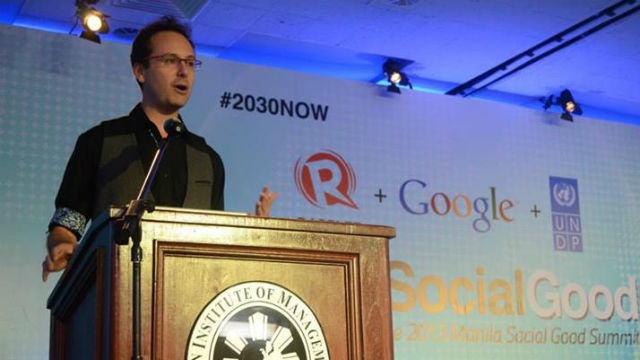SUMMARY
This is AI generated summarization, which may have errors. For context, always refer to the full article.

MANILA, Philippines – How can social media and new technologies reinforce disaster response, mitigation and resilience?
Furtheremore, how can individuals and groups use such technologies to help out during disasters? What can government institutions and disaster responders benefit from these?
READ: Helping out: disaster response and volunteerism
Social media and technology expert Andrew McGlinchey discussed concrete steps on how technology and social media can help improve disaster response and promote disaster resiliency at the PH+SocialGood Summit on Saturday, September 21.
Crisis mapping
McGlinchey, Google’s product manager in South East Asia, pointed out that the company’s crisis response activities were triggered by the 2010 Haiti earthquake that resulted in some 220,000 deaths, according to the Haitian government.
Google’s crisis maps can be used to keep track of casualties and damage. It is created with the help of crowdsourcing data and other critical information.
McGlinchey said the landing page banks on the internet giant’s capacity to support millions of hits and spikes in users. In addition, a Google crisis map can be accessed on desktop and mobile and gives public alerts.
Another disaster initiative by Google is the Person Finder, a way to track people in the aftermath of a disaster. The application also uses crowdsourcing – people can report missing people and provide information to help locate them.
During the 2011 Japan tsunami, people stuck in shelters posted the names of their relatives on whiteboards. Volunteers transcribed the information and put it online so others could access the list.
Volunteers needed
Despite the new technologies, McGlinchey emphasized the importance of having “volunteers who’ll do the heavy lifting.” He called for volunteers who will empower the heroes (real life responders).
McGlinchey also said that volunteers are needed in filling up the gaps in Google’s map maker so it can be used during disasters. The maps are publicly open and user generated.
He noted, however, that such information can only be useful if it is used by the public before disasters strike.
“When the water is already as high as the basketball ring, that’s not the time to learn. Now is the time when we should be planning out how to do it,” he said.
He said the biggest challenge is getting the data from the agencies that have it. He put emphasis on “finding all sources and information that people need ahead of time” and not during disasters.
“Think already now on how we can share this info so that in the event of a crisis, Google and others can help organize this information,” McGlinchey said.
Stepping up
The advent of social media, as McGlinchey presented, brought more avenues for heroism and volunteerism. Now, volunteers are no longer limited to helping out during relief and rescue operations.
READ: #ProjectAgos: A call to action
The platforms for heroism and volunteerism, like social media, are expanding. Even by tweeting and posting online, people can contribute concrete solutions during disasters. Excuses for inaction are slowly shrinking.
READ: PH+SocialGood: Heroes wanted
This is the age where the online world concretely affects real life. Social media can be used for social good. –Rappler.com
Add a comment
How does this make you feel?
There are no comments yet. Add your comment to start the conversation.